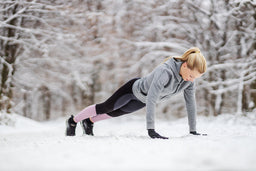
Why it’s time to look at plyometric training
Why it’s time to look at plyometric training
The appetite for fitness and building strength is growing, not just here in the UK but around the world. However, avoiding the fads and deciphering the buzzwords that have flooded the sector can be a challenge, particularly for those new to the concept of plyometric training. Taking inspiration from professional athletes and incorporating plyometric training into workouts could not only improve performance and develop explosive power but deliver the results that fitness fans today are looking for.
The good news is that plyometric training doesn’t demand expensive equipment – it’s possible to start a programme to build on your current fitness levels from you own home with simple, effective exercises.
What is plyometric exercising?
Not come across the term plyometric exercising before? In simple terms, it means jump training. When doing plyo exercises you’ll exert maximum force over short intervals to increase your power. By moving between muscle extension and muscle contraction before and after jumps rapidly, you can build up strength, along with improving balance, symmetry, and control.
It's a technique that’s commonly used it the professional fitness world, particularly in sports where explosive movement is required. Whether you play tennis or are part of a basketball team, including plyometric exercises in your fitness routine can take it up a step and deliver you benefits.
Why choose plyometric training?
Plyometric training has a lot going for it. Not only does it live up to expectations, helping active people meet their goals, but it’s a fitness concept that’s simple to integrate into your current workout routines. Interested in trying out plyometric training? You could experience these benefits:
Build explosive power
Plyo training is all about explosive movements and you’ll find that your power improves rapidly when you incorporate the exercises into your routine. Most sports involve some explosive movements, whether it’s kicking or rotating, and upping your explosive power could be the key to your athletic success and improving your aesthetics.
Improve athleticism
If you’re a fitness fanatic, improving your athleticism is no doubt high up on the list of your goals. Plyo training helps to add more energy to your movements, with added speed and power. From running to throwing, plyometrics can boost your overall performance and endurance, aspects that are sure to be welcomed by anyone that is a fitness fan.
Ideal for sportspeople and power athletes
For dedicated sportspeople and athletes, plyometric exercises are ideal. They’ll give you extra power and strength, a bonus whether your chosen sport is football or squash. The plyo exercises can give you an added advantage when it comes to competing, helping to support your goals.
Add resistance while be kinder to joints
Plyometric training can take your workout up a gear by adding a resistance and increasing the challenge. While other exercises might place additional pressure on your joints and increase the risk of injury, plyo training is a kinder option, helping you keep going for longer and seeing the results of your efforts.
Why isn’t plyometric training more popular?
While athletes, particularly sprinters and high jumpers, extensively use plyometric training to boost their performance and power, it’s used in the overall fitness field to a lesser degree, despite the benefits of the technique and exercises. Gyms today are often filled with high-tech equipment that can aim to improve performance and support goals. But many don’t have plyometric equipment, including plyo boxes, unless they’re specialist or high end fitness centres.
However, as demand for simple but effective exercises and routines are on the rise, plyometric training is set to reach new heights as more people take up the process. While, your typical gym might not cater to plyo converts, that doesn’t mean you need to make expensive investments to get started. A simple plyo box is all you need.
5 plyometric exercises to try at home
To really benefit from plyometric training, you’ll need to do a series of jumps or hops at a quick pace. The jumps force your muscles to stretch and contract, effectively whipping them into shape thanks to the high level of intensity.
If you’re ready to give plyometric exercises a try, you can do a whole-body workout with just a plyo box at home, giving you flexibility to tailor your fitness routine when it suits you. Get started with these five simple but effective exercises:
Front box jump – This is one of the most common plyo exercises, increasing strength of your quads and glutes. With the box placed around 15cm in front of you, stand in squat position before exploding your entire body to land on the box, step down to repeat a full set.
Lateral box jump – Moving laterally means using your muscles in a different way and can support lots of different sports, such as tennis and dodgeball. Standing to the side of the box spring quickly onto it, in the same manner as a front jump. Make sure you jump from both sides equally, to maintain symmetry and improve balance.
Plyo push-ups – Plyo push-ups involve starting from the bottom of a push-up position and explode off the ground, with the aim of getting a maximum height. A plyo box can support your efforts with this exercise if you’re new to it, by distributing your weight, or if you’re looking for a challenge by placing your feet on the box.
Elevated knee touches – This exercise can improve your arm and core strength. In a plank position with your feet placed on the plyo box, bring one knee to your shoulder, tightening your core and shoulders, before placing back in the original position. Repeat using alternate sides.
Lateral box shuffles – Doing this exercise will help improve your speed. Standing at the plyo box from the side, place one foot on the box and the other on the floor around 15cm away. In squat position, you need to simultaneously move your foot on the box to the opposite side on the floor and the one that was on the floor to the top of the box, moving at speed from one side to the other.
































